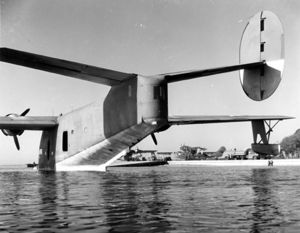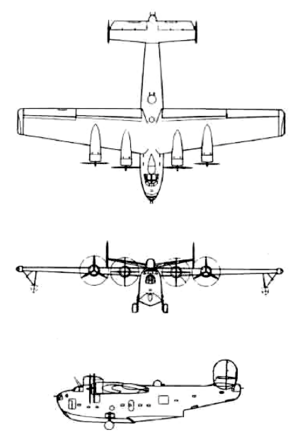PlaneSpottingWorld welcomes all new members! Please gives your ideas at the Terminal.
PB2Y Coronado
| Consolidated PB2Y Coronado | |
|---|---|
| An early PB2Y-2 in flight. | |
| Type | Maritime patrol bomber |
| Manufacturer | Consolidated Aircraft |
| Maiden flight | December 1937 |
| Status | Retired |
| Primary users | United States Navy Royal Air Force |
The PB2Y Coronado was a large flying boat patrol bomber designed by Consolidated Aircraft. After deliveries of the PBY Catalina, also a Consolidated aircraft, began in 1935, the United States Navy began planning for the next generation of patrol bombers. Orders for two prototypes, the XPB2Y-1 and the Sikorsky XPBS-1, were placed in 1936; the prototype Coronado first flew in December of 1937.[1]
One Coronado remains, as of 2005, at the Pensacola, Florida National Museum of Naval Aviation.
Development
After trials with the XPB2Y-1 prototype revealed some stability issues, the design was finalized as the PB2Y-2, with a large cantilever wing, twin tail, and four Pratt & Whitney R-1830 radial engines. The two inner engines were fitted with four-bladed reversible pitch propellers; the outer engines had standard three-bladed feathering props.[2] Like the PBY Catalina before it, the PB2Y’s wingtip floats retracted to reduce drag and increase range.

Development continued throughout the war. The PB2Y-3, featuring self-sealing fuel tanks and additional armor, entered service just after the attack on Pearl Harbor and formed most of the early-war Coronado fleet. The prototype XPB2Y-4 was powered by four Wright R-2600 radials and offered improved performance, but the increases were not enough to justify a full fleet update. However, most PB2Y-3 models were converted to the PB2Y-5 standard, with the R-1830 engines replaced with single-stage R-1830-92 models. As most existing P2BY-3s were used as transports, flying low to avoid combat, removing the excess weight of unneeded superchargers allowed an increased payload without harming low-altitude performance.
Coronados served in combat in the Pacific, in both bombing and anti-submarine roles. Transport and hospital aircraft were the most common, however; the aircraft used by the British under Lend-Lease were outfitted purely as transports.
Operators
Specifications (PB2Y-5)
Data from Jane's Fighting Aircraft of World War II[2]
General characteristics
- Crew: 10
- Length: 79 ft 3 in (24.2 m)
- Wingspan: 115 ft 0 in (35 m)
- Height: 27 ft 6 in (8.4 m)
- Wing area: 1,780 ft² (165 m²)
- Empty weight: 40,850 lb (18,530 kg)
- Max takeoff weight: 66,000 lb (30,000 kg)
- Powerplant: 4× Pratt & Whitney R-1830-92 radial engines, 1,200 hp (900 kW) each
Performance
- Maximum speed: 194 mph (168 knots, 310 km/h)
- Cruise speed: 170 mph (148 knots, 272 km/h)
- Range: 1,070 mi (930 nm, 1,720 km) at 131 mph (210 km/h)
- Service ceiling: 20,500 ft (6,250 m)
Armament
- Guns:
- 6× .50 in (12.7 mm) M2 Browning machine guns in three powered turrets
- 2× .50 in M2 Browning machine guns in waist mounts
- Bombs:
- 2× Mark 13 torpedoes or
- Up to 12,000 lb of bombs, housed in the wings
References
- ↑ Andrews, Hal (November-December 1989). "PB2Y Coronado". Naval Aviation News 72 (No. 1): 22-23. Template:ISSN.
- ↑ 2.0 2.1 Jane, Fred T. “The Consolidated Vultee Model 29 Coronado.” Jane’s Fighting Aircraft of World War II. London: Studio, 1946. p. 218-219. ISBN 1 85170 493 0.
Related content
Related development
Comparable aircraft
Designation sequence
| 32 (B-24) | |
| 32 (PB4Y) |
Related lists
Lists relating to aviation | |
|---|---|
| General | Timeline of aviation · Aircraft · Aircraft manufacturers · Aircraft engines · Aircraft engine manufacturers · Airports · Airlines |
| Military | Air forces · Aircraft weapons · Missiles · Unmanned aerial vehicles (UAVs) · Experimental aircraft |
| Notable incidents and accidents | Military aviation · Airliners · General aviation · Famous aviation-related deaths |
| Records | Flight airspeed record · Flight distance record · Flight altitude record · Flight endurance record · Most produced aircraft |

